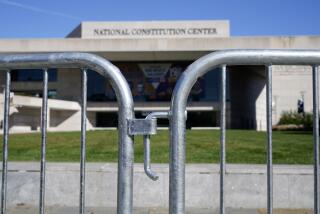Arming the Mideast: For What? : U.S. Weapon Sales to Israel Set the Pace
CAIRO — Egypt put on an exhibition last November to show the representatives of 200 international companies the products of its newest industry. Eleven types of weapons were on display.
The weapons ranged from a radar-equipped missile, the local version of the Soviet SAM-7, to the Fahd armored personnel carrier, named for the king of Saudi Arabia. There were long-range 122-millimeter artillery pieces and 23-millimeter anti-aircraft guns, plus the Alpha ground-support jet, the Gazelle helicopter and the Mirage 2000 fighter, all French but all produced and assembled in Egypt.
It was an impressive arsenal for a dirt-poor country with per capita income of only $560 a year. Egypt’s fledgling arms industry already brings in $1 billion a year in hard currency and has surpassed in importance three traditional pillars of the Egyptian economy, cotton, tourism and Suez Canal revenues.
“The Egyptian industrial-military base is at the service of the Arab world,” Defense Minister Abdel Halim Abu Ghazala said in a press conference at the exhibition. He quickly added that Egypt’s motivation was not economic--”We aren’t arms dealers”--but was based on the desire to provide Arab governments easy access to weapons at low prices.
Few others see Egypt as being so altruistic. Egypt hopes to become a major weapons merchant for the Third World--its first tanks are scheduled to roll off the production line by 1989--and its November exhibition served to underscore the frantic arms race that has made the Middle East the world’s principal weapons-importing region.
The Middle East has less than 3% of the world’s people yet accounts for more than 8% of the world’s military spending. Its governments spend $350 per person per year for military purposes, three times the world average, and import almost half of all the weapons sold to the Third World, according to the Stockholm International Peace Research Institute.
Between 1984 and 1990, according to a report by the British firm of Frost & Sullivan Ltd., Middle East arms purchases are expected to reach $33 billion. Another $26 billion is expected to be spent throughout the region on construction of facilities and maintenance. In the meantime, the 17 Arab armies--they now total 2.2 million men--are growing.
Even with declining oil revenues, military budgets are usually the last to be cut. Oman devotes 40% of its budget to defense. Saudi Arabia spends $2,700 per capita per year on its military. Defense spending in the United Arab Emirates has increased 56-fold since 1974. Egypt has more men in uniform today (460,000) than it did in 1979, before the Egyptian-Israeli peace treaty.
But who is the enemy?
Fifteen years ago, it was Israel and, rhetorically at least, that is the rationale most Arab governments continue to cite for for military buildup.
Kuwait’s Defense Minister Salem el Sabah said in 1983: “We need to protect Kuwaiti territory and provide backing to other Arab armies so they can . . . regain their usurped lands.”
Realistically, though, most Arab governments neither seek nor expect renewed war with Israel. The legacy of Anwar Sadat, the late Egyptian president, was to shift the focus of the Arab-Israeli conflict from the battlefield to the negotiating table. And today in the Islamic world of the Middle East, with Arab leaders less preoccupied with Israel than they were a decade or so ago, the enemy is within.
Saudi Arabia and the Persian Gulf states fear the spread of Iran’s religious extremism and worry about their own internal security. Lebanon is in chaos. The Iraq-Iran war is in its fifth year. Egypt and Syria are suspicious of each other’s military aims. No one trusts Libya. Morocco and Algeria support different sides in the 10-year-old Western Sahara war. Oman views with concern South Yemen, against whom it has fought a war.
One exception is Tunisia, which tries to get along with everyone and spends only 2% of its budget on defense. As a consequence, Tunisia is dismissed by its Arab neighbors as insignificant. As a Western diplomat put it, “In the Middle East. if you’ve got no guns, you’ve got no respect.” The observation, he noted, has a sad ring of truth the world over.
Although war with Israel is not on the minds of most Arab leaders these days, they nevertheless want to maintain some sort of military parity with Israel. Thus it is the United States’ arms shipments to Israel that in many ways set the pace of arms sales throughout the Middle East.
The United States and France are the principal arms suppliers to the Middle East, ranking far ahead of the Soviet Union, whose major regional clients are Syria, Libya and South Yemen. But Britain, West Germany, China, Spain, Brazil, Canada, the Netherlands and Turkey also sell in this lucrative market.
According to a Library of Congress study last year, the United States has passed the Soviet Union as the major exporter of weapons to the Third World, with nearly $10 billion in deliveries in 1983. Internationally, the arms trade involves $35 billion a year.
More to Read
Sign up for Essential California
The most important California stories and recommendations in your inbox every morning.
You may occasionally receive promotional content from the Los Angeles Times.










